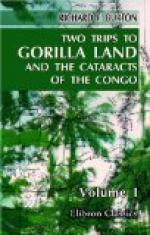I have italicized the passages which show that the traditions still preserved on the coast, about the Pongo and the Chimpanzee, date from old. Surely M. du Chaillu does grave injustice to this good old Briton, who was not a literary man, by declaring his stories to be mere travellers’ tales, “untrue of any of the great apes of Africa.” Battel had evidently not seen the animal, and with his negro informants he confounds the gorilla and the “bushman;” yet he possibly alludes to a species which has escaped M. du Chaillu and other modern observers.
Mr. W. Winwood Reade ("Savage Africa,” chap, xix.) has done good service by reprinting the letter of a Bristol trader on the west coast of Africa, first published by Lord Monboddo ("Origin and Progress of Language,” vol. i. p. 281, 1774 to 1792). Here we find distinct mention of three anthropoid apes. The first is the “Impungu” (or pongo?), which walks upright, and is from seven to nine feet high. The second is the “Itsena,” evidently the Njina, Nji, Nguyla, or gorilla; and thirdly is the “Chimpenza,” our Chimpanzee, a word corrupted from the Congoese Kampenzy, including the Nchigo, the Kulu-Kamba, and other Troglodytes. I have heard of this upright-walking Mpongo at Loango and other places on the west coast of Africa, where the Njina is familiarly spoken of, and it is not, methinks, impossible, that an ape even larger than the gorilla may yet be found.
James Barbot ("A Voyage to Congo River,” Churchill, vol. v. p. 512,) tells us in 1700 that the “kingdom of Angola, or Dongo, produces many such extraordinary apes in the woods; they are called by the blacks Quojas morrow, and by the Indians Orang-outang, that is satyrs, or woodmen. . . . This creature seems to be the very satyr of the ancients, written of by Pliny and others, and is said to set upon women in the woods, and sometimes upon armed men.” Amongst these animals he evidently includes the chimpanzee, as may be seen by his reference to the Royal Exchange, London.
In 1776 the philosophical Abbe Proyart, in his excellent “History of Loango,” tells us (vide the chapter upon animals) that “there are in the forests baboons four feet high; the negroes affirm that, when they are hard pushed, they come down from the trees with sticks in their hands to defend themselves against those who are hunting them, and that very often they chase their pursuers. The missionaries never witnessed this singularity.” According to the people, gorillas five or six feet tall have been seen as lately as 1840 at “Looboo Wood,” a well-known spot which we shall presently sight, about three miles inland from the centre of Loango Bay.




